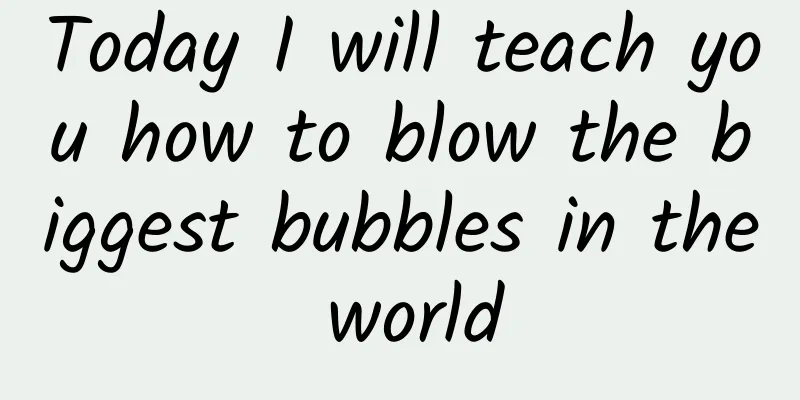Today I will teach you how to blow the biggest bubbles in the world

|
I believe most people have played the game of blowing bubbles when they were young. After all, which boy doesn’t want to show off his skills in front of the girl he likes, and which girl doesn’t like bubbles shining with colorful light in the sun? However, it may not be so simple to play with bubbles. Although bubbles seem fragile, they actually have some complex physical knowledge as a basis for support. For a long time, in the field of physics, blowing bubbles has always been a "serious science". So there is a group of seemingly serious physicists who are actually thinking about how to "blow" the best and biggest bubbles in the world. If you want to know why, don't ask. The answer is to blow the biggest bubbles! How to blow bubbles well? As early as the 19th century, Belgian physicist Joseph Plateau outlined four basic surface tension laws that determine the structure of soap films, known as Plateau's laws. According to the law he proposed, bubbles are round because of the surface tension of water. Due to the existence of gravity, the liquid is pulled down by this force, but the mutual attraction between water molecules is stronger than the attraction between water molecules and air, so the surface area between the gas and liquid increases. In this process, the liquid gradually "gets fatter" and its shape looks like a circle. When the given volume remains unchanged, the surface area of the circle is the smallest, that is, the least energy is required , so the bubble develops in the direction of roundness. After Prato, many scientists have also started to join the work of "how to blow bubbles". Don't laugh too quickly, this is not for entertainment, they are just having fun. In the 1940s, American botanist Edwin Matzke began to make bubbles by hand in his laboratory. He noticed that the shape of the bubbles was very similar to cells in plant tissues, so he tried to interpret certain characteristics of cells through bubbles... (I have to say, the idea is very unique.) By 1994, mathematicians from Ireland no longer blew bubbles themselves, but used computer modeling to determine the best bubble geometry; in addition, scientists in Germany and the United States used acoustic levitation (huge sound waves) to suspend bubbles in mid-air in order to observe the effect of ambient sound on the complex harmonic structure of the bubbles. (It looks very impressive..) More recently, in 2006, scientists from Harvard University discovered that adding tiny colloidal particles to soap can form a "protective film" outside the bubble water, making the bubbles more stable and able to shape them into different shapes. In addition, scientists have even built a preliminary microfluidic bubble logic (AND/OR/NOT) device that can be used to deliver therapeutic drugs or chemical reagents. How to blow big bubbles? But in recent years, physicists have turned to a new direction - how to blow the bubbles bigger? Since it is "blowing", the role of airflow is inevitable. In 2016, two physicists from the French National Center for Scientific Research developed a theoretical model to test the exact mechanism of bubble formation when airflow is sprayed onto a soap film. To this end, they also specially made a large "bubble-making" device to open a vertical soap film that is one meter wide. First, the soap solution is carefully poured onto the wires of the device, and then the two wires that are stuck together are pulled apart to allow the soap solution to form a thin soap film. After the preparation was completed, they sprayed gas with different flow rates onto the soap film and used a high-speed camera to observe the speed of the blown gas and the generation of bubbles. The results showed that bubbles will only form above a certain speed, and the speed depends on the width of the jet airflow. If the jet is wider, the threshold for bubble formation will be lower. In simple terms, the jet airflow must be equal to or even wider than the width of your soap film, so that bubbles will be more easily formed . You may also recall the small stick you used to blow bubbles when you were a child. The circle on it is usually smaller than your mouth because we blow out the air through our mouth. This is not the end. Based on the above research, mathematicians from the Applied Mathematics Laboratory of New York University have made fine adjustments and further derived the flow rate required to push the liquid film to form bubbles, as well as related parameters such as this flow rate and circle size. According to their experiments, airflow affects bubbles in two different ways: one is to use strong and steady wind to push the round soap film to form bubbles; the other is to deliver slow and gentle wind into small bubbles and then slowly blow them bigger . The giant bubbles we see in street performances use the first method. The performers will run or wave their arms quickly to provide the strong and stable airflow needed for the soap film to become "concave." In addition to the airflow factor, the composition of the soap solution is another very important factor in "blowing big bubbles". At this point, we have to mention Associate Professor Justin Burton from Emory University in the United States. While attending a meeting in Barcelona, he encountered a street performer blowing huge bubbles. Under the sunlight, the bubbles showed the optical phenomenon of thin film interference. Professor Burton knew that this was due to the interference pattern produced when light reflected from the two surfaces of the film. What surprised him was not this, but how such a thin bubble could maintain such a large surface area without bursting. So he went home and started studying the formula of bubbles, and also asked his students to play blowing bubbles together in the laboratory. After many experiments, he found that polymers played a crucial role in the formation of large bubbles, because polymers can increase the toughness of bubbles, allowing the bubbles to be blown bigger and less likely to burst. Justin Burton and his students playing with bubbles Finally, I will briefly introduce to you the entry-level formula for big bubbles: 1KG of plasma water (just ordinary mineral water), 50ml of detergent, 2-3g of guar gum (a common thickening food additive that acts as a polymer), 2g of baking powder, and 50ml of alcohol. In addition to the recipe, the tool for blowing big bubbles is also important. The Soap Bubble Wiki introduces a homemade tool that can absorb as much bubble water as possible and blow big bubbles. (It probably looks like this...) Students who have the conditions may wish to try it themselves. Those who successfully blow giant bubbles can leave a message to tell everyone, or post it for everyone to see. |
<<: How "anti-human" is the right-angle shoulder? Orthopedic doctors tell the truth...
>>: Dogs start to age at the age of 6. How can we make them live longer and healthier?
Recommend
Sales volume plummeted by nearly 30%, Honda announced a strategic transformation, and the industry generally adopted a cautious attitude
GAC Honda recently announced its "Innovative...
Apple is going to fail in 2020? Cook: Let's see who earns more than me
In recent years, the most common voice in the tec...
Making Question Answering More Natural - Research on Natural Answer Generation System Based on Copy and Retrieval Mechanism
Making machines as intelligent as humans has alwa...
Should we cut advertising budgets during the epidemic? Shouldn’t!
Some time ago, I wrote an article titled "Wh...
Man sues bank after girlfriend secretly shops online
A young man born in the 1980s found that the paym...
Hello, are you there, Helicobacter pylori
Helicobacter pylori, I know these words, but why ...
Event Operation: How to plan a wonderful membership event?
Normally, we think of event operation as a part o...
How to do Tik Tok short video marketing in 2019?
Tik Tok was launched on September 26, 2016. After...
Creative guide to Spring Festival topic marketing!
How to do 5-minute topic marketing during the Spr...
[Popular Science of Chinese Military Technology] How does armor perspective technology allow tank soldiers to use "hacks"?
With the progress of the times, the wide area and...
Six things you need to know to make your product popular
As the way information is disseminated has gradua...
Tesla recalls 734 imported Model 3s due to risk of loose screws
According to the official website of the State Ad...
When APP is obsessed with algorithms, can we understand "ourselves" through personalized customization?
In today's world where algorithm recommendati...
Brand promotion: How to create a hit product?
When it comes to hot products, what do you think ...
How do overseas bloggers calculate promotion costs? Overseas advertising rules!
Table of contents 1. How do overseas bloggers cal...









